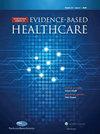延长头孢菌素、青霉素类和碳青霉烯类的输注:对存活败血症运动指南的成本效益观点和关键评估
Q3 Medicine
International Journal of Evidence-Based Healthcare
Pub Date : 2022-11-21
DOI:10.17267/2675-021xevidence.2022.e4605
引用次数: 0
摘要
叙述/介绍。在最后一版的生存败血症运动指南- SSC指南-关于优化抗生素药代动力学和药效学(PK/PD)的建议。其中,建议延长β -内酰胺类药物(青霉素类、头孢菌素类和碳青霉烯类)的输注,以改善临床和微生物预后。然而,根据作者的说法,这些建议需要对延长输注的经济意义进行研究——成本效益研究。脓毒症在世界范围内是一个巨大的经济负担,因为需要医院和ICU床位、合格的工作人员和治疗病理的疗法,而众所周知,抗生素是主要的治疗方法。成本效益研究的基本研究问题是了解一种新的、更昂贵的干预措施相对于“标准”治疗的优越性,然后,从卫生系统和时间的角度来看,这意味着什么。然而,延长抗生素输注已显示出对临床结果的益处,并且考虑到达到相同的PK/PD和临床效果所需的抗生素量更少,因此使用抗生素比标准方法更便宜,可以降低直接成本。此外,延长输注的额外费用不会很大,而且更有效的治疗也可以减轻卫生系统的间接经济负担。因此,它超出了成本效益分析的范围,应纳入卫生系统。本文章由计算机程序翻译,如有差异,请以英文原文为准。
Extended infusion of cephalosporins, penicillins and carbapenems: a cost-effective point-of-view and critical appraisal of Surviving Sepsis Campaign guidelines
Narrative/ introduction. In the last edition of the Surviving Sepsis Campaign guidelines - SSC guidelines - recommendations regarding the optimization of antibiotics pharmacokinetics and pharmacodynamics (PK/PD) were made. Among these, the use of extended infusion of beta-lactams (penicillins, cephalosporins and carbapenems), are proposed to improve clinical and microbiological outcomes. However, according to the authors, studies of the economic implications of extended infusion – cost-effectiveness studies – are needed for these recommendations.
Caveats. Sepsis represents a huge economic burden around the world due to the need for hospital and ICU beds, qualified staff and therapies for the treatment of the pathology, whereas it is known that antibiotics are the mainstay therapy. The basic research question for cost-effectiveness studies is to understand the superiority of a new and more expensive intervention over the "standard" therapy and, then, the implications of this in a health system and time perspective. However, extended infusion of antibiotics has shown a benefit in clinical outcomes and its use can reduce direct costs since is less expensive than the standard approach, considering that smaller amounts of the antibiotic are needed to reach the same PK/PD and clinical effect. Moreover, additional costs to do an extended infusion would not be significant, and more effective therapy could also reduce the indirect economic burden on the health systems. Therefore, it is beyond the scope of cost-effectiveness analyses, and should be incorporated by health systems.
求助全文
通过发布文献求助,成功后即可免费获取论文全文。
去求助
来源期刊

International Journal of Evidence-Based Healthcare
Medicine-Health Policy
CiteScore
1.80
自引率
0.00%
发文量
39
期刊介绍:
The International Journal of Evidence-Based Healthcare is the official journal of the Joanna Briggs Institute. It is a fully refereed journal that publishes manuscripts relating to evidence-based medicine and evidence-based practice. It publishes papers containing reliable evidence to assist health professionals in their evaluation and decision-making, and to inform health professionals, students and researchers of outcomes, debates and developments in evidence-based medicine and healthcare.
The journal provides a unique home for publication of systematic reviews (quantitative, qualitative, mixed methods, economic, scoping and prevalence) and implementation projects including the synthesis, transfer and utilisation of evidence in clinical practice. Original scholarly work relating to the synthesis (translation science), transfer (distribution) and utilization (implementation science and evaluation) of evidence to inform multidisciplinary healthcare practice is considered for publication. The journal also publishes original scholarly commentary pieces relating to the generation and synthesis of evidence for practice and quality improvement, the use and evaluation of evidence in practice, and the process of conducting systematic reviews (methodology) which covers quantitative, qualitative, mixed methods, economic, scoping and prevalence methods. In addition, the journal’s content includes implementation projects including the transfer and utilisation of evidence in clinical practice as well as providing a forum for the debate of issues surrounding evidence-based healthcare.
 求助内容:
求助内容: 应助结果提醒方式:
应助结果提醒方式:


